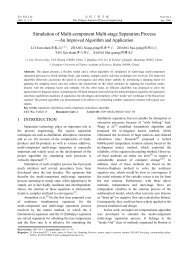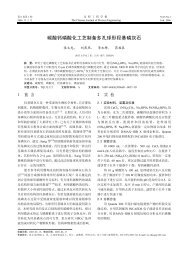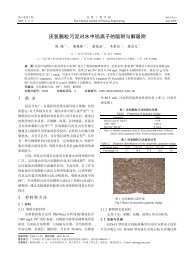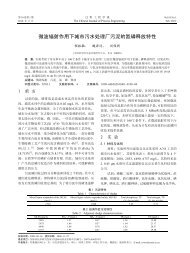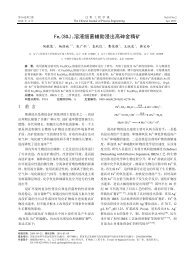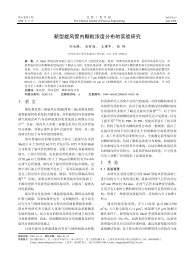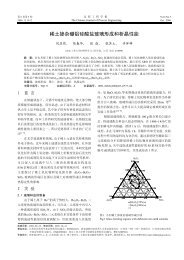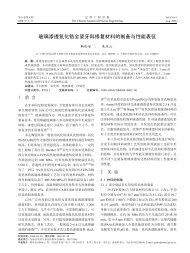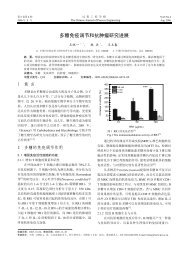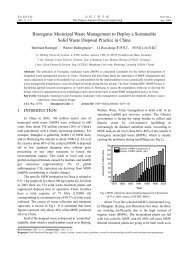1182 过 程 工 程 学 报 第 8 卷the MFC, anaerobic experiments with E. <strong>coli</strong> cells wereinitiated in order to pre-adapt bacterial metabolism in ananaerobic envir<strong>on</strong>ment, then E. <strong>coli</strong>′s electrochemicalactivity was improved to some extent. So MFC couldrapidly generate electricity <strong>and</strong> attain stable state.3.2 <strong>On</strong>-<strong>electrode</strong> Taming MethodsBiofilm attached to <strong>electrode</strong> is developed asfollows: bacterial attachment to <strong>electrode</strong>, earlymaturati<strong>on</strong> <strong>and</strong> acquisiti<strong>on</strong> of biofilm structure, maturebiofilm, <strong>and</strong> bacterial detachment [22] . The electricitygenerati<strong>on</strong> of MFC is extremely related to the formedmature biofilm attached to the <strong>electrode</strong> [6,19,20] . However,most of MFC bacterial taming methods usually needrepeatedly scrap biofilm to select <strong>and</strong> optimize bacteria,but the operati<strong>on</strong> of scraping biofilm can result in theloss of electrochemical activity of biofilm <strong>and</strong>postp<strong>on</strong>ing the time that biofilm again matures.<strong>On</strong>-<strong>electrode</strong> taming method judges the maturati<strong>on</strong> ofbiofilm according to the voltage−ampere curve of MFC,which means that the current density of MFC justattains the plateau phase (reaching the peak currentdensity) when the biofilm has matured [3,6,19,20] , theoperati<strong>on</strong>s of <strong>on</strong>-<strong>electrode</strong> taming without scraping offof biofilm can simply <strong>and</strong> rapidly achieve the bacterialselecti<strong>on</strong> <strong>and</strong> optimizati<strong>on</strong>.During the experiments, when the MFC attainedthe plateau of current density for the first time, thebiofilm attached to carb<strong>on</strong> paper had matured, <strong>and</strong> theelectrochemically activated E. <strong>coli</strong> biomass wasaccumulated, meantime, the anode soluti<strong>on</strong> wasremoved out to eliminate the infecti<strong>on</strong> of accumulatedoutgrowth <strong>and</strong> detached cells in the anode chamber afterthe MFC run for a l<strong>on</strong>g time [6,8] , <strong>and</strong> the anode chamberwas rapidly added with 40 mL medium to anaerobicallyculture the mature E. <strong>coli</strong> biofilm attached to the<strong>electrode</strong>, <strong>and</strong> the electrochemical activity of E. <strong>coli</strong>biofilm was c<strong>on</strong>served. When MFC was again addedwith anolyte to carry out the electrochemical test, itspeak current density was increased, <strong>and</strong> the time toreach the peak current value was reduced. Successiveanaerobic cultivati<strong>on</strong> <strong>and</strong> electrochemical test werecarried out to tame of E. <strong>coli</strong> biofilm <strong>and</strong> graduallyimprove the electrochemical activity of E. <strong>coli</strong> biofilm.As shown in Fig.5, after the 4 th taming (n=4), themaximum current density of E. <strong>coli</strong> MFC <strong>and</strong> theparental (n=0) E. <strong>coli</strong> MFC was respectively 612.5 <strong>and</strong>397.5 mA/m 2 , namely the biofilms attached to the<strong>electrode</strong>s had matured. We can see from theexperimental data that the maturati<strong>on</strong> time of tamedbiofilm was obviously reduced to 240 min, quickeningup 1 times compared with that of parental E. <strong>coli</strong>,meantime, the maximum current density of the tamed E.<strong>coli</strong> MFC was increased 0.54 times compared with thatof parental E. <strong>coli</strong> MFC.Current density (mA/m 2 )400650390 (a) Before taming600(b) After the 4th taming380370550360500350450340400330350320200 250 300 350 400 450 500 550300200 250 300 350 400 450 500Time (min)Time (min)Fig.5 Relati<strong>on</strong>ship between current density <strong>and</strong> time in MFCs before <strong>and</strong> after taming of E. <strong>coli</strong>Figure 6 shows the relati<strong>on</strong>ship of cell voltage <strong>and</strong>power density with current density of MFC in thetaming process under n=0, 2, 4. After the 4 th<strong>on</strong>-<strong>electrode</strong> taming (n=4), the maximum power densityof tamed E. <strong>coli</strong> MFC reached 166.67 mW/m 2 ,increasing 64% compared with the maximum powerdensity 101.81 mW/m 2 of the parental E. <strong>coli</strong> MFC(n=0).As summarized in Fig.7, after the 4 th <strong>on</strong>-<strong>electrode</strong>taming, the electricity generati<strong>on</strong> of tamed E. <strong>coli</strong> MFCwas remarkably improved compared with the electricityCurret density (mA/m 2 )generati<strong>on</strong> of parental E. <strong>coli</strong> MFC, the tamed E. <strong>coli</strong>MFC showed a 54% improvement in peak currentdensity, reaching 612.50 mA/m 2 , a 64% improvement inmaximum power output, reaching166.67 mW/m 2 . Zou etal. [9] reported a parental E. <strong>coli</strong> MFC, its maximum poweroutput was 70% of that of the MFC in this work, being116 mW/m 2 , <strong>and</strong> the initial c<strong>on</strong>centrati<strong>on</strong> of E. <strong>coli</strong> inthe literature was 220% of that in this work, being 2.73mg/mL.Because taming of mediator MFC bacteria byserial transfer was not reported in the literature, in the
第 6 期 XI Ming-yue, et al.: <str<strong>on</strong>g>Preliminary</str<strong>on</strong>g> <str<strong>on</strong>g>Study</str<strong>on</strong>g> <strong>on</strong> E. <strong>coli</strong> <strong>Microbial</strong> <strong>Fuel</strong> <strong>Cell</strong> <strong>and</strong> <strong>On</strong>-<strong>electrode</strong> Taming of the Biocatalyst 1183<strong>Cell</strong> voltage (V)0.451800.401600.351400.30120n0.250 1000.2028040.15600.10400.05200.000 300 600 900 1200 1500 1800Power density (mW/m 2 )Peak current density (mA/m 2 )6005505004504000 2 4 6170160150140130120110100Maximum power density (mW/m) 2 )Current density (mA/m 2 )Taming timesFig.6 Relati<strong>on</strong>ships of current density with voltage<strong>and</strong> power density in taming processesFig.7 Relati<strong>on</strong>ships of taming times with the maximumcurrent <strong>and</strong> power densitypresent experiments, we ever attempted to adopt theoperating steps of literature [11] to tame E. <strong>coli</strong>. Theelectr<strong>on</strong> mediator NMB was added for taming ofmediator MFC bacteria, however, plenty of black-greendepositi<strong>on</strong> was found in diluent, which led to theremarkable fluctuati<strong>on</strong> of experimental data. Whether ornot this method can be adopted for taming of mediatorMFC bacteria still needs more research.Owing to benefiting envir<strong>on</strong>mental protecti<strong>on</strong>,electricity generati<strong>on</strong> with sludge <strong>and</strong> sewage hasimportant significance to development of MFC. Rabaeyet al. [12] tamed of a mixed bacterial culture in themediator-less MFC via repeatedly scraping biofilm, butthis method had tamed for 7 times <strong>and</strong> 63 d. The<strong>on</strong>-<strong>electrode</strong> taming method reported in this work hasno special requirement to the types of bacteria <strong>and</strong> doesnot need to scrap off biofilm, so the advantages ofsimple operati<strong>on</strong> <strong>and</strong> short time make <strong>on</strong>-<strong>electrode</strong>taming method a highly promising c<strong>and</strong>idate forapplicati<strong>on</strong> in microbially aggressive envir<strong>on</strong>ments likesewage or sludge.4 CONCLUSIONS(1) A mediator microbial fuel cell (MFC) wasc<strong>on</strong>structed with E. <strong>coli</strong> in this work. The capabilities ofthe MFC were even better than those reported in theliterature so far for E. <strong>coli</strong> MFCs. E. <strong>coli</strong> cells werecarried out in anaerobic growth prior to inoculatingthem into the MFC in order to pre–adapt bacterialmetabolism in an anaerobic envir<strong>on</strong>ment, the anaerobicgrowth operates simply, <strong>and</strong> may apply to improveelectrochemical activity of all kinds of MFCbiocatalysts. The electricity generati<strong>on</strong> of E. <strong>coli</strong> MFCis characterized with the following data: when the initialc<strong>on</strong>centrati<strong>on</strong> of E. <strong>coli</strong> cells was 3.41 mg/mL, themaximum power density of MFC reached 263.94mW/m 2 with the corresp<strong>on</strong>ding current density of1287.50 mA/m 2 . The internal resistance of MFC was200 Ω.(2) After the 4 th <strong>on</strong>-<strong>electrode</strong> taming, the electricitygenerati<strong>on</strong> of tamed E. <strong>coli</strong> MFC was compared withthe electricity generati<strong>on</strong> of parental E. <strong>coli</strong> MFC whenthe initial c<strong>on</strong>centrati<strong>on</strong> of E. <strong>coli</strong> cells was 1.24 mg/mL,the tamed E. <strong>coli</strong> MFC showed a 54% improvement inpeak current density, being 612.50 mA/m 2 ; a 64%improvement in maximum power output, reaching166.67 mW/m 2 . In the meantime, the maturati<strong>on</strong> time oftamed biofilm was obviously reduced to 240 min,quickening 1 times compared with that of parental E.<strong>coli</strong> biofilm. The <strong>on</strong>-<strong>electrode</strong> taming method describedhere does not need to scrap off biofilm, <strong>and</strong> has theobvious advantages of the less taming times <strong>and</strong> shortertaming time.REFERENCES:[1] Kim J R, Jung S H, Regan J M, et al. Electricity Generati<strong>on</strong> <strong>and</strong><strong>Microbial</strong> Community Analysis of Alcohol Powered <strong>Microbial</strong> <strong>Fuel</strong><strong>Cell</strong>s [J]. Bioresour. Technol., 2007, 98(13): 2568−2577.[2] Frank D, S′eamus P J Higs<strong>on</strong>. Biofuel <strong>Cell</strong>s—Recent Advances <strong>and</strong>Applicati<strong>on</strong>s [J]. Biosens. Bioelectr<strong>on</strong>., 2007, 22(7): 1224−1235.[3] Lovley D R. <strong>Microbial</strong> <strong>Fuel</strong> <strong>Cell</strong>: Novel <strong>Microbial</strong> Physiologies <strong>and</strong>Engineering Approaches [J]. Curr. Opin. Biotechnol., 2006, 17(3):327–332.[4] K<strong>on</strong>g X Y, Li L H, Sun Y M, et al. Fundamental <str<strong>on</strong>g>Study</str<strong>on</strong>g> <strong>on</strong> <strong>Microbial</strong><strong>Fuel</strong> <strong>Cell</strong> <strong>and</strong> Influent Factors <strong>on</strong> Output Power [J]. Modern Chem.Ind., 2007, 27(2): 282−286 (in Chinese).[5] H<strong>on</strong>g Y G, Guo J, Sun G P. Recent Progress in Electricigens <strong>and</strong><strong>Microbial</strong> <strong>Fuel</strong> <strong>Cell</strong> [J]. Acta Microbiologica Sinica, 2007, 47(1):173−177 (in Chinese).[6] Lian J, Feng Y L, Li H R, et al. C<strong>on</strong>structi<strong>on</strong> <strong>and</strong> <str<strong>on</strong>g>Preliminary</str<strong>on</strong>g> Studies<strong>on</strong> the Direct <strong>Microbial</strong> <strong>Fuel</strong> <strong>Cell</strong> [J]. The Chinese Journal of ProcessEngineering, 2006, 6(3): 408−412 (in Chinese).[7] Kim H J, Park H S, Hyun M S, et al. A Mediator-less <strong>Microbial</strong> <strong>Fuel</strong><strong>Cell</strong> Using a Metal Reducing Bacterium, Shewanella utrefacien [J].Enzyme Microb. Technol., 2002, 30(2): 145–152.[8] Park D H, Zeikus J G. Electricity Generati<strong>on</strong> in <strong>Microbial</strong> <strong>Fuel</strong> <strong>Cell</strong>sUsing Neutral Red as an Electr<strong>on</strong>ophore [J]. Appl. Envir<strong>on</strong>.




